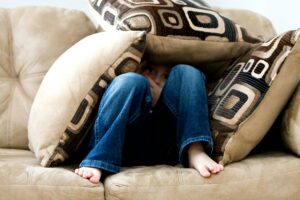Traumatic brain injury (TBI) is a devastating condition that affects millions of people worldwide. TBI involves the temporary or permanent impairment of brain function following physical trauma to the brain and can be caused by a blow to the head, a fall, or a car accident. It can cause a wide range of symptoms, including chronic pain, difficulty with thinking (called ‘brain fog’), memory, movement, and speech. TBI can cause various impairments in cognitive, emotional, and physical functioning, depending on the severity and location of the injury. TBI can also increase the risk of developing psychiatric disorders, such as depression, anxiety, and post-traumatic stress disorder (PTSD). Transcranial magnetic stimulation (TMS) is a non-invasive technique that uses magnetic pulses to stimulate specific regions of the brain. TMS can modify the activity of neural pathways and circuits that are involved in various functions and behaviors. TMS has been explored as a potential intervention for TBI patients, with the rationale that it could enhance neuroplasticity, reduce inflammation, and improve mood regulation.
Effects of TBI and How TMS Can Help
One of the most challenging consequences of TBI is the impairment of psychomotor function, cognition, and emotion processing. These functions are essential for performing daily activities, maintaining social relationships, and achieving personal goals. However, these functions are mediated by different brain regions and pathways that can be damaged or disrupted by TBI. Therefore, it is important to understand how TBI affects these functions and how they can be measured and modulated by interventions.
TMS can measure and alter the effects of TBI on these functions by stimulating specific brain regions and measuring the changes in cortical excitability and interhemispheric interactions. Cortical excitability refers to the responsiveness of neurons to stimulation, which reflects their level of activity and plasticity. Interhemispheric interactions refer to the communication and integration of information between the two hemispheres of the brain. In TBI, cortical excitability deficits and changes depend on various factors, such as the injury, its severity, time-lapse following injury, the rehabilitation care provided, as well as individual factors.
TBI can also affect other aspects of brain function, such as cerebral blood flow, metabolism, neurogenesis, neuroinflammation, neurodegeneration, and neuroplasticity. These factors can interact with cortical excitability and interhemispheric interactions and influence the recovery and outcome of TBI patients.
TMS and Motor Recovery after TBI
One of the main goals of rehabilitation after TBI is to facilitate motor recovery, especially for the upper limbs. Motor impairments after TBI can result from damage to the primary motor cortex, the corticospinal tract, or other brain regions and pathways involved in motor control and coordination.
To measure cortical excitability and interhemispheric interactions in the motor system, TMS can apply a single or paired-pulse to a specific brain region and excite the target muscle. TBI patients often show reduced excitability in the motor cortex on the same side as their injuries (ipsilesional) as compared to the motor cortex in the preserved hemisphere (contralesional) and healthy controls. This is often correlated with measures of manual dexterity and function.1
TMS can also apply repetitive pulses (rTMS) to a specific brain region at different frequencies and intensities and induce changes in neural activity and plasticity that can enhance or inhibit motor function. Several studies have evaluated the effects of rTMS on motor recovery after TBI. Some promising findings have emerged. For example, rTMS applied to the motor cortex has been shown to improve hand dexterity and grip strength in TBI patients with upper limb impairment,2 finger tapping speed and accuracy, 3 and hand function in cerebral stroke patients with non-trauma-induced brain injuries.4 These studies suggest that rTMS could have beneficial effects on motor recovery after TBI by influencing cortical excitability and interhemispheric interactions of the motor system.
Other studies suggest that rTMS may not be effective for all TBI patients or for all types of symptoms. This could be due to various factors such as the location of the injury, severity of the injury, and the time passed since the injury. TBI can cause widespread damage to the brain, making it difficult to target specific areas with rTMS. Additionally, TBI can also cause overall changes in the brain’s electrical activity, which may make it difficult for rTMS to have an effect.
Consequently, more research is needed to establish the optimal parameters, mechanisms, and predictors of motor recovery response to TMS in patients with TBI.
TMS and Cognitive and Emotional Recovery after TBI
TBI can also have various effects on cognitive and emotional recovery, such as impairments in memory, attention, executive function, social cognition, and emotion regulation. TMS can be used to measure the cortical excitability and interhemispheric interactions of the cognitive and emotional systems after TBI. TBI patients often show reduced excitability in response to stimulation of the prefrontal cortex, which is involved in executive function.5
TMS has been shown to be safe and well tolerated in a study of patients who had developed depression after a TBI. In a placebo-controlled trial, 21 patients received 20 sessions of rTMS to both sides of the brain over 4 weeks. There were significant improvements in cognition following active TMS in the areas of working memory and executive function.6 TMS has been shown to modulate brain activity and connectivity in regions associated with attention, executive function, emotion regulation, and social cognition in patients with moderate to severe TBI.7, 8
Additionally, TMS has been shown to reduce pain intensity and improve quality of life in TBI patients with chronic pain. In a case report study9 of patients who complained of severe pain in the left or right side of the body below the neck area after a car accident, rTMS was administered to the contralateral motor cortex on the more painful side. After TMS, all patients in this study reported pain relief. Relatedly, TMS has also been found to relieve TBI-related headaches and associated depressive symptoms though altering the body’s pain control system.10 These systemic effects greatly differ from the mechanisms of widely available analgesics, which mainly work by hiding the headache symptoms. 10 Most pain relievers have many unwanted side effects and do not directly address the functional problems. Therefore, noninvasive brain stimulation methods such as rTMS are a great option to both improve the brain function and reduce the TBI-related symptoms like chronic headache.
All in all, these studies suggest that rTMS could have beneficial effects on cognitive and emotional recovery after TBI by modulating cortical excitability and interhemispheric interactions of the cognitive and emotional systems. rTMS could potentially offer a novel and effective option for TBI patients who do not respond well to conventional treatments or who experience adverse effects from medications.
MeRT TMS (individualized alpha wave EEG-guided TMS) is highly effective at addressing the impact of TBI on brain fog, sleep, mood, and tinnitus.
TMS is a promising technique that could provide a non-invasive and effective intervention for TBI survivors who suffer from various impairments in motor, cognitive, and emotional functions.
One of the future directions for using TMS in TBI rehabilitation is to explore the optimal ways of combining TMS with other interventions, such as cognitive rehabilitation, pharmacotherapy, or physical therapy. Another aim is to measure and modulate the interactions between TMS and other interventions using neuroimaging or behavioral techniques. Additionally, it will be important to explore using TMS in TBI rehabilitation to personalize TMS targets and parameters for each TBI patient, considering the heterogeneity of TBI etiology, severity, location, and time since injury.
References
- Pruski A, Cantarero G. Transcranial Direct Current Stimulation for Motor Recovery Following Brain Injury. Current Physical Medicine and Rehabilitation Reports. 2020;8(3):268–79.
- Castel-Lacanal E, Tarri M, Loubinoux I, et al. Transcranial magnetic stimulation in brain injury. Ann Fr Anesth Reanim. 2014;33(2):83-87. doi:10.1016/j.annfar.2013.11.006
- Volz LJ, Vollmer M, Michely J, Fink GR, Rothwell JC, Grefkes C. Time-dependent functional role of the contralesional motor cortex after stroke. Neuroimage Clin. 2017;16:165-174. Published 2017 Jul 25. doi:10.1016/j.nicl.2017.07.024
- Chen Y-J, Huang Y-Z, Chen C-Y, Chen C-L, Chen H-C, Wu C-Y, et al.. Intermittent theta burst stimulation enhances upper limb motor function in patients with chronic stroke: a pilot randomized controlled trial. BMC Neurology [Internet]. 2019;19(1). Available from: https://dx.doi.org/10.1186/s12883-019-1302-x
- Nandrajog P, Idris Z, Azlen WN, Liyana A, Abdullah JM. The use of event-related potential (P300) and neuropsychological testing to evaluate cognitive impairment in mild traumatic brain injury patients. Asian J Neurosurg. 2017;12(3):447-453. doi:10.4103/1793-5482.180921
- Hoy KE, McQueen S, Elliot D, Herring SE, Maller JJ, Fitzgerald PB. A Pilot Investigation of Repetitive Transcranial Magnetic Stimulation for Post-Traumatic Brain Injury Depression: Safety, Tolerability, and Efficacy. J Neurotrauma. 2019;36(13):2092-2098. doi:10.1089/neu.2018.6097
- Ahorsu DK, Adjaottor ES, Lam BYH. Intervention Effect of Non-Invasive Brain Stimulation on Cognitive Functions among People with Traumatic Brain Injury: A Systematic Review and Meta-Analysis. Brain Sciences. 2021;11(7):840.
- Begemann MJ, Brand BA, Ćurčić-Blake B, Aleman A, Sommer IE. Efficacy of non-invasive brain stimulation on cognitive functioning in brain disorders: a meta-analysis. Psychological Medicine. 2020;50(15):2465-2486. doi:10.1017/S0033291720003670
- Kang DH, Kim GW. Changes in Diffuse Tensor Imaging and Therapeutic Effect of Repetitive Transcranial Magnetic Stimulation in Traumatic Brain Injury with Central Pain. Brain Sci. 2020;10(12):929. Published 2020 Dec 2. doi:10.3390/brainsci10120929
- Leung A, Metzger-Smith V, He Y, Cordero J, Ehlert B, Song D, Lin L, Golshan S, Tsai A, Vaninetti M, Rutledge T. Left dorsolateral prefrontal cortex rTMS in alleviating MTBI related headaches and depressive symptoms. Neuromodulation: Technology at the Neural Interface. 2018 Jun 1;21(4):390-401.
- Crowder C et al. A Chart Review to Assess the Response of Veterans, Suffering from Tinnitus to Alpha Burst Transcranial Magnetic stimulation
- Makale M et al. Preliminary Observations of Personalized Repetitive Magnetic Stimulation (PrTMS) Guided by EEG Spectra for Concussion






